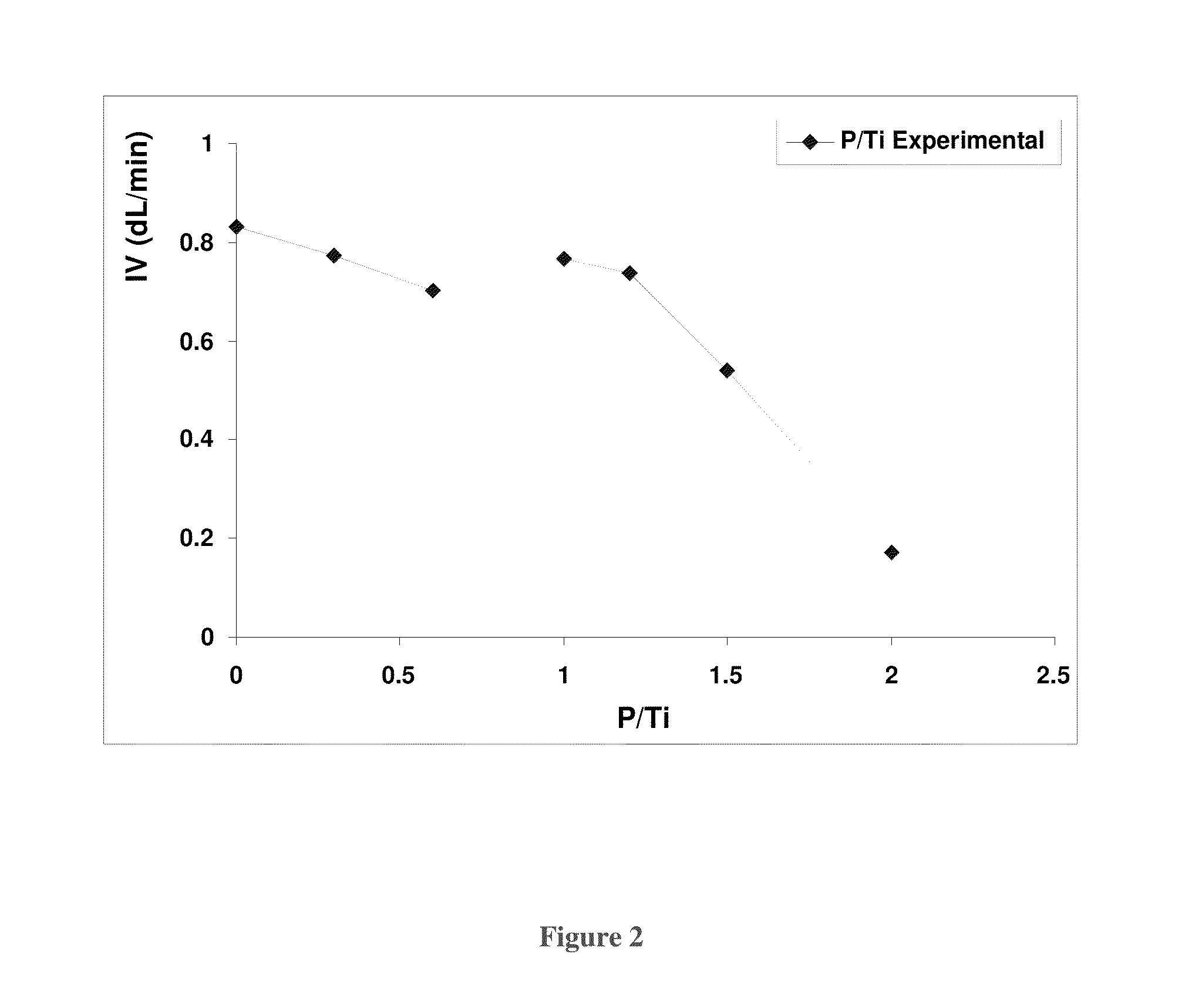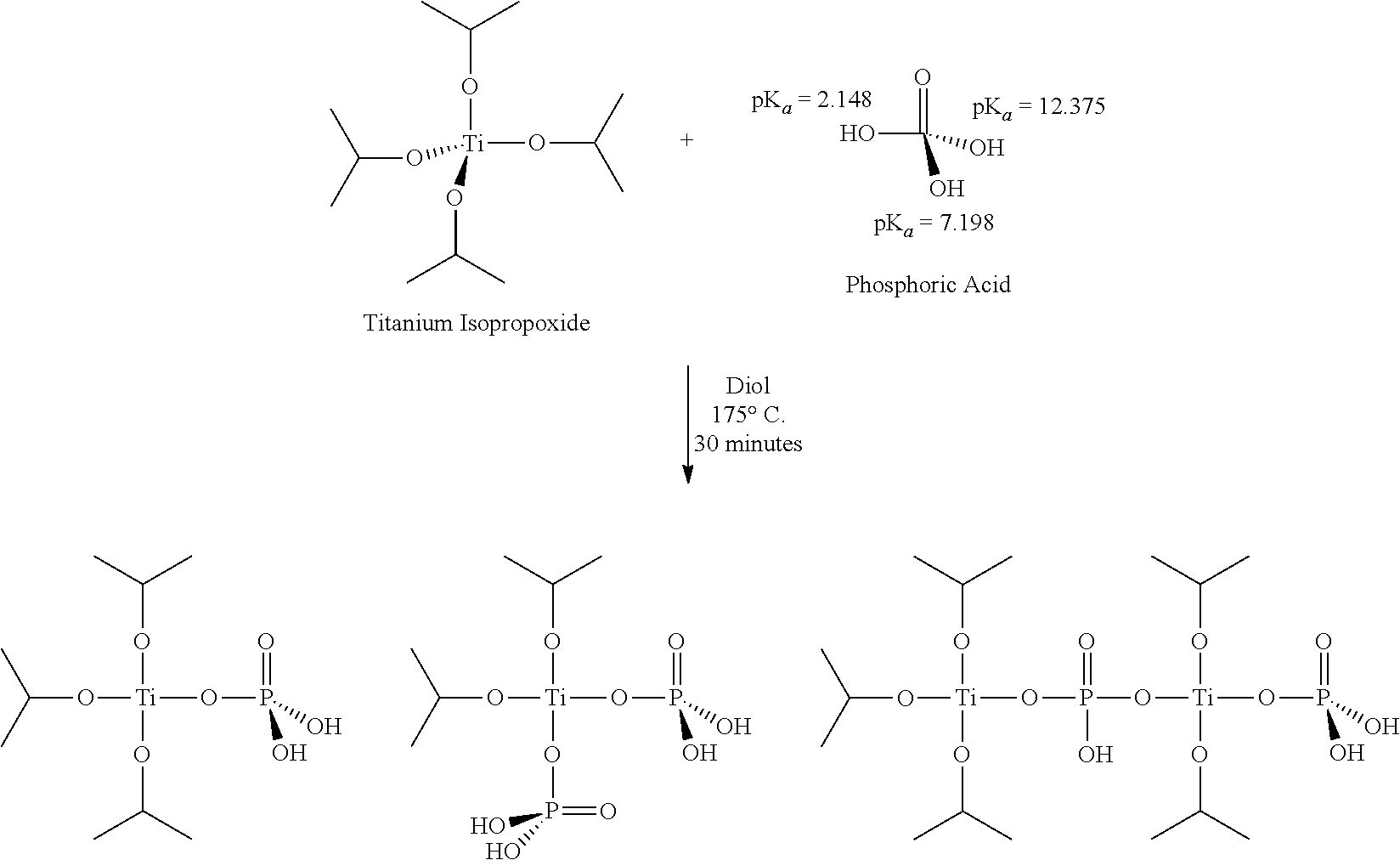Method for the preparation of polyalkylene terephthalate resin compositions employing titanium-containing catalyst complex
a technology of polyalkylene terephthalate and catalyst complex, which is applied in the direction of chemical recycling, etc., can solve the problems of promoting degradation of polymer chains, undesirable reaction of pbt in subsequent processing, and loss of mechanical properties
- Summary
- Abstract
- Description
- Claims
- Application Information
AI Technical Summary
Benefits of technology
Problems solved by technology
Method used
Image
Examples
examples
[0086]Following is a list of materials, acronyms, and selected sources used in the examples.[0087]BDO: 1,4-Butanediol (from BASF, with a purity specification of 99.5 wt. %)[0088]DMT: Dimethyl Terephthalic acid (from Acros)[0089]TPT: Tetraisopropyl titanate, also referred to as titanium tetraisopropoxide (from DuPont, commercial TYZOR grade)[0090]HP: Phosphoric acid (from Acros)[0091]PBT: Poly(butylene terephthalate) as synthesized
Equipment
[0092]The PBT resins were prepared as a lab scale in a 1-L 3-necked round bottom flask equipped with a condenser and a vacuum output.
Procedures and Testing of Polyester Resins
[0093]Dynamic scanning calorimetry (DSC), employing a Perkin Elmer® DSC 7 equipped with Pyris DSC 7 software, was used to determine melting characteristics of the polymers synthesized. In a typical procedure, a polymer sample (10-20 mg) was heated from 50° C. to 200° C. (20° C. / min), held at 200° C. for 1 min, cooled back to −50° C. (20° C. / min), then held at −50° C. for 1 min...
examples 1-7
Comparative Example C-1
[0095]In Comparative Example 1, PBT was prepared on a lab scale from DMT and 1,4-butanediol (BDO) in which 87.4 g of DMT and 140 g of BDO were introduced into a three-neck round bottom flask. The reactor was placed in an oil bath at a temperature of 170° C. Then 250 ppm of TPT was added to the reaction mixture and the ester interchange temperature was increased to 220° C. at a rate of 2° C. / min while stirring at 260 rpm under nitrogen. Evolution of methanol was collected separately until no more droplets of the methanol were collected. The temperature of the reaction mixture was increased further to 250° C. The polymerization stage was initiated with vacuum adjusted to below 1 Torr for 1 hour. The polymerization was stopped after achieving the desired intrinsic viscosity.
example 2
[0096]Example 1 was implemented in the presence of the new titanium-containing catalyst prepared in situ by complexation between titanium tetraisopropoxide (TPT) and phosphoric acid at 1:0.3 mol ratio. First, 50 g of BDO and the phosphoric acid solution in water (0.1 g / ml) were introduced into a three-neck round bottom flask. The reactor was placed in an oil bath temperature of 175° C. After 20 minutes, 250 ppm of TPT was added to the reactor and an in situ complexation between the phosphoric acid and TPT was carried out for 40 minutes under N2 atmosphere to form a catalyst solution. Then, 87.4 g of DMT and 80 g of additional BDO were introduced into the catalyst solution and, for ester interchange, the temperature was increased to 220° C. at a rate of 2° C. / min while stirring at 260 rpm under nitrogen. After the volatiles from methanol ceased, the temperature of the reaction mixture was further increased to 250° C. The polymerization was initiated with the vacuum adjusted to below ...
PUM
| Property | Measurement | Unit |
|---|---|---|
| temperature | aaaaa | aaaaa |
| pressure | aaaaa | aaaaa |
| temperature | aaaaa | aaaaa |
Abstract
Description
Claims
Application Information
 Login to View More
Login to View More - R&D
- Intellectual Property
- Life Sciences
- Materials
- Tech Scout
- Unparalleled Data Quality
- Higher Quality Content
- 60% Fewer Hallucinations
Browse by: Latest US Patents, China's latest patents, Technical Efficacy Thesaurus, Application Domain, Technology Topic, Popular Technical Reports.
© 2025 PatSnap. All rights reserved.Legal|Privacy policy|Modern Slavery Act Transparency Statement|Sitemap|About US| Contact US: help@patsnap.com



